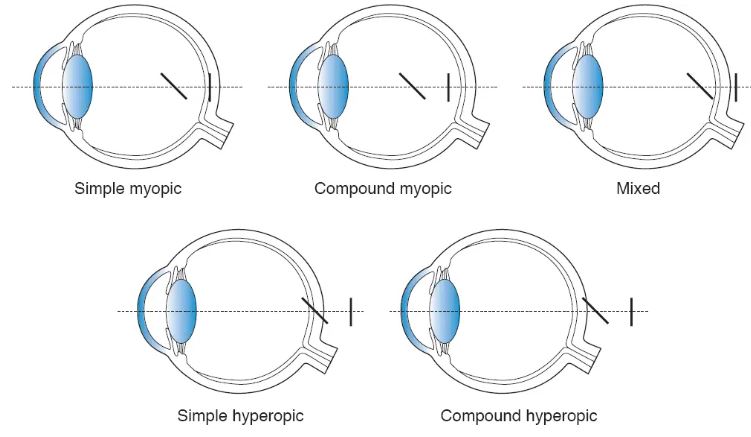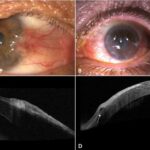Mixed astigmatism is a common vision problem that affects millions of people worldwide. It can cause blurry vision and other discomforting symptoms that can have a significant impact on an individual’s quality of life. The condition is a subdivision of a group of refractive errors known as Astigmatism. To better understand mixed astigmatism we need to grab what refractive errors mean and what astigmatism itself means.
Refractive error
Refractive error is a common vision problem that occurs when the shape of the eye prevents light from focusing directly on the retina. It can be caused by a variety of factors including the shape of the cornea, lens, or the length of the eyebal. There are three main types, myopia (shortsightedness), hyperopia (longsightedness), and Astigmatism.
- In myopia, light focuses in front of the retina due to a steeped cornea or longer eyeball.
- For hyperopia, light focuses in behind the retina due to a ‘flat’ cornea or shorter eyeball.
- In Astigmatism, light focuses at different meridians/points on the retina. Some of these meridians can be in front of the retina, behind the retina (like in myopia and hyperopia respectively), or both.

Astigmatism
Astigmatism is where light rays passing through the eye cannot converge at a particular focal point but form focal lines. In other words, astigmatism is a condition where parallel rays of light passing from the cornea do not converge to a point focused on the retina due to an irregularly shaped cornea or lens. The condition can cause objects to appear distorted or blurry, leading to eye strain, headaches, and other discomforting symptoms. There are three types of astigmatism: simple astigmatism, compound astigmatism, and mixed astigmatism.
Simple Astigmatism
When light rays are focused in front of the retina in one meridian, it is called simple myopic astigmatism. When they are focussed behind the retina, this is labeled simple hyperopic astigmatism
Compound astigmatism
Compound myopic astigmatism occurs when the rays of light in both meridians converge in front of the retina, while compound hyperopic astigmatism is characterized by the convergence of rays behind the retina.
Mixed Astigmatism
In this situation, light rays in one meridian converge in front of the retina, while in another meridian they converge behind the retina. As a result, one meridian is myopic, and another is hyperopic. This makes it challenging to focus on both near and distant objects, leading to blurry vision. The condition can be congenital or acquired and can affect one or both eyes.

Symptoms of Mixed Astigmatism
The symptoms of mixed astigmatism can vary from person to person and depend on the severity of the condition. Some common symptoms include:
- Blurry or distorted vision
- Eye strain and fatigue
- Headaches
- Squinting
- Difficulty seeing at night
- Sensitivity to light
Diagnosis of Mixed Astigmatism
Diagnosis of Mixed Astigmatism is a crucial step towards effective treatment. There are several tests that eye doctors perform to diagnose mixed astigmatism accurately. These tests include:
- Eye Examination: An eye examination is the first step to determine if there are any abnormalities in the structure of the eye. During this examination, the eye doctor will examine the cornea, lens, and retina to identify any signs of irregularity that may be causing the mixed astigmatism.
- Refraction Test: A refraction test is a standard diagnostic test that determines the exact prescription for corrective lenses. The eye doctor will use special instruments including a retinoscope, a phoropter, or a trial lens set to measure the eye’s ability to focus light waves and determine the appropriate corrective lens prescription.
- Corneal Topography: Corneal topography is a non-invasive imaging test that maps the surface of the cornea. This test allows the eye doctor to detect any irregularities in the cornea’s shape, which can cause mixed astigmatism.
- Wavefront Analysis: Wavefront analysis is a diagnostic tool that measures how light waves travel through the eyes, allowing the eye doctor to detect any distortions or aberrations in vision. This test enables doctors to create a custom treatment plan for mixed astigmatism.
Treatment Options for Mixed Astigmatism
Mixed astigmatism can be effectively managed through a variety of treatment options. The choice of treatment depends on the severity of the condition, age, lifestyle, and personal preferences (discuss with your doctor). The most common treatment options are:
- Eyeglasses: Eyeglasses are a simple and effective treatment option for mixed astigmatism. They work by bending light waves to correct vision problems. Eyeglasses are easy to wear and can provide instant relief from blurry vision. They come in various designs and styles, including single-vision, bifocal, or progressive lenses.
- Contact lenses: Contact lenses are another popular treatment option for mixed astigmatism. They work by creating a smooth and uniform refractive surface on the cornea. Contact lenses are available in various types, including soft, rigid gas permeable, and hybrid lenses. Contact lenses can provide clear and crisp vision, but they require daily maintenance and cleaning.
- LASIK surgery: LASIK surgery is a popular surgical procedure that uses a laser to reshape the cornea, correcting vision problems. LASIK is a safe and effective treatment option for mixed astigmatism, providing long-lasting results. LASIK surgery is a quick and painless procedure that can correct severe vision problems. However, it is expensive and not suitable for all individuals.
- Photorefractive Keratectomy (PRK): Photorefractive keratectomy (PRK) is another surgical procedure that uses a laser to reshape the cornea to correct astigmatism. PRK is an excellent treatment option for patients who are not suitable for LASIK surgery. PRK surgery has a longer recovery time than LASIK surgery and may cause temporary vision problems.
- Implantable Lenses: Implantable lenses are a relatively new treatment option for mixed astigmatism. They work by replacing the natural lens of the eye with an artificial lens that can correct refractive errors. Implantable lenses can provide clear and crisp vision, but they are expensive and require surgery.
Conclusion
Mixed astigmatism can be a challenging condition to manage but with proper diagnosis and treatment, it is possible to achieve clear and crisp vision. Whether you choose eyeglasses, contact lenses, or surgery, it is essential to work closely with your eye doctor to determine the best treatment option for your specific needs.
References
- Gurnani, B. (2023, June 26). Astigmatism. StatPearls [Internet].
- Remón, L., Tornel, M., & Furlan, W. D. (2006). Visual acuity in simple myopic astigmatism: influence of cylinder axis. Optometry and Vision Science, 83(5), 311-315.
- Parrey, M. U. R., & Elmorsy, E. (2019). Prevalence and pattern of refractive errors among Saudi adults. Pakistan Journal of Medical Sciences, 35(2), 394-398.
- Xu, G., Xu, B., & Zhou, J. (1996). A clinical report on mixed astigmatism. Zhonghua Yan Ke Za Zhi, 32(2), 126-129.
- Gurnani, B., & Kaur, K. (2021). iTrace aberrometry-Identifying occult imperfections in the visual system. Kerala Journal of Ophthalmology, 33(3), 373-383.




